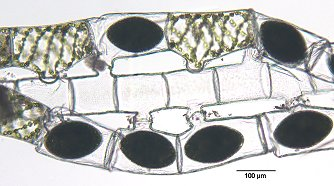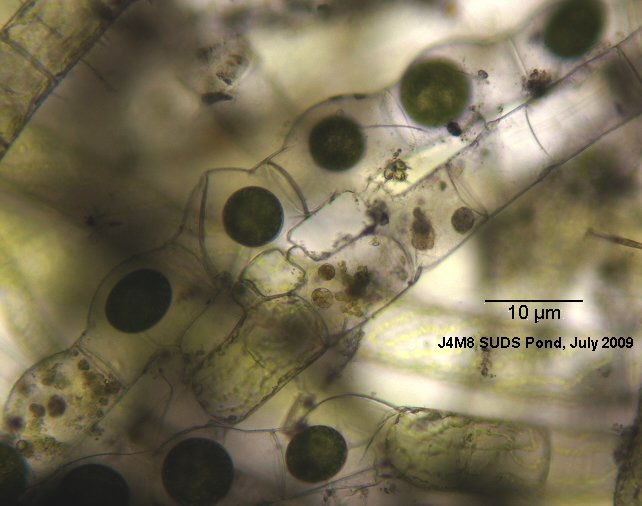
Reproduction
Spirogyra has the ability to reproduce sexually and asexually. Sexual Reproduction happens only under adverse situations, like if the pond or ditch were to dry up. Reproduction occurs in the spring around April through June, and is most successful in stagnant freshwater. Asexual reproduction happens through the fragmentation of cells. Sexual reproduction can occur through two types: scalariform conjugation and lateral conjugation. Filaments change from green to brown during conjugation.
Scalariform (Ladder-like) Conjugation occurs when two different filaments line up side-by-side for part or all of their length. One cell from each filament in line emits tubular protuberances that elongate and fuse to create a conjugation canal. The cytoplasm of the cell acts as the male in this case and travels through the tube to meet up and fuse with the female cytoplasm. The gametes then fuse to form a zygospore. Sometimes more than two filaments can take part in the conjugation at a time.
The center filament has no zygospores because it has donated its contents and other participating cells’ contents to nearby filaments.
In Lateral Conjugation, gametes are formed in the same filament. Two adjoining cells near the transverse wall form protuberances that create the conjugation canal on contact. The male cytoplasm migrates through the tube fusing with the female, fulfilling the same process from here on out as Scalariform Conjugation.
This photograph shows the rhizoid-like branches (also known as geniculations or ‘knee-bends’) that grow out of a filament in hopes to contact another.
During Asexual Reproduction, Fragmentation takes place, and the organism undergoes intercalary mitosis, which produces new filaments.
Mature Zygospores
This video demonstrates sexual attraction between two filaments side-by-side.
Now that you have seen this green algae's Habitat, Reproduction, Nutrition, and Adaptations, you need to know how they Interact....


